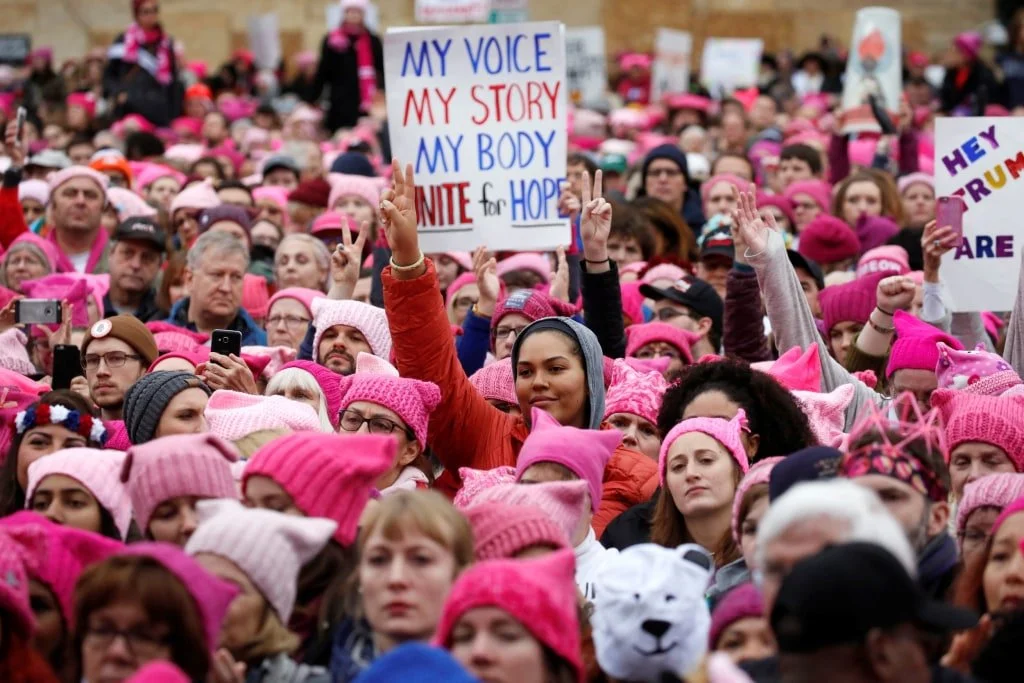All protests in history have adopted specific signs as symbols which represent them. Official colours, iconography, flowers and animals associated with the spirit of the specific movement function as identifiers to mobilise supporters, push their agenda and demand space.
These symbols are also used to spread ideologies, secret messages and codes, as well as to promote solidarity. Influenced by the socio-political context, geography and cultural trends of the time, these symbols appear during protests and meetings on clothes, posters, and banners. Let us take a look at the origin of some of the early feminist symbols that we carry along even today:
Decoding Feminist Colours: Pink, Purple, White, Green and Gold
While there are no official colours for the feminist movement as such, some colours were preferred and even desired for their meaning and impact by certain groups. These colours could be found on sashes, posters, banners and were also worn during the protest marches.
One might think the colour associated with feminism is the colour pink due to the recent ‘reclaiming’ of the colour by Fourth Wave feminist activists, film stars and artists. We are familiar with the concept of Pink Politics where Hollywood stars such as Kerry Washington, Amy Schumer and Zoe Saldana wore hot pink pantsuits during the 2020 elections. Indian films such as Gulab Gang (Soumik Sen, 2014) and Pink (Aniruddha Roy Chowdhury, 2016) had also adopted the colour as a symbolic statement to talk about feminist issues.
This is not a random association as the colour pink has had quite the political history related to gendering and royalty. Up until the 1920s, pink had a masculine appeal as the colour is closely related to another supposedly ‘masculine’ colour – Red, which is why royals and nobility dressed boys in pink and girls in blue! However, by the end of the World Wars, pink started being associated with women instead.
This sudden change is attributed to men wearing neutral colours to work and women wearing brighter colours and settling back into a domestic lifestyle. By the 1980s, with the emergence of ultrasound, it was used to detect the gender of a foetus. Pink had become the colour for baby girls, conversely, blue became the colour for baby boys. Unfortunately, this ludicrous idea of gendered colours still exists, but the is actively challenged everyday by women, members of the LGBTQIA+ community and allies who wear pink to celebrate their femininity and the parts of themselves that is looked down upon by the patriarchal ideas and the gender binary. Therefore, many feminist movements use pink as their defining colour to reclaim pink and assert power. “In 2020, pink has become the ‘colour disruptor’ – the colour of change for so many around the world,” explains Andrew Burnstine, associate professor at Lynn University.
One of the most important tools feminists use to fight patriarchy are clothes. During the suffragist movements, women had to fight for their right to drive bicycles which was largely frowned upon by the society. For a comfortable bike ride, a need for bloomers became a necessity as the pompous skirts and trousers gathered at the bottom and would cause accidents. Although the garment came out of practicality, bloomers became a symbol of unrestrictive clothing and new opportunities for women in the 1890s
The colour Purple, which is also the official colour for the International Women’s Day, has roots in the first wave of feminist movements. The Women’s Social and Political Union of England were the first to adopt purple (symbolising loyalty and justice), white (symbolising purity) and green (symbolising hope) as common colours for their protest marches in 1908. The National American Woman Suffrage Association and The Congressional Union for Women’s Suffrage took cue from the English suffragettes and adopted purple, white and gold as their colours, symbolising beacon of hope.
Also read: The Colour Pink: The Colour Of Our Battlefields
In the 1914 marches in Washington DC, Suffragettes marched in all white which was not only photographed and created an impact, but also metaphorically fought the idea that women who voted were unchaste.
Iconography
The suffragist movement had regional chapters which gave us a variety of different icons on posters and banners. In many states, the banners and posters reappropriated symbols from the American Revolution such as the liberty tree, shining sun, USA flag colours and stars. Alice Paul, leader of the National Woman’s Party, is known to have sewn stars on a giant purple, white, and gold flag in 1919.
The suffragettes who had been to jail were given to wear a silver pin shaped like a jail cell door with a heart-shaped padlock by the National Women’s Party during the silent marches in Washington DC.
During the second wave of feminism, the Rosie the Riveter ‘We Can do it’ poster became a common icon. The poster was made during the wars as an encouragement for women to take up manufacturing jobs as men had left for the war. However, the poster was forgotten after the wars only to reappear in the 1960s as a symbol of American feminism and to advocate for women’s financial independence.
These symbols have been adopted contextually at various times to ascribe different meanings to feminist struggles. We carry some of these forward even today, while some remain relics and remnants of a history of resistance. There have evolved new symbols, signs and colours both internationally and regionally to address the growing spectrum of the feminist discourse. Each of these symbols add to the movement’s depth and must be documented and celebrated
Decoding clothes from bloomers to bras
One of the most important tools feminists use to fight patriarchy are clothes. During the suffragist movements, women had to fight for their right to drive bicycles which was largely frowned upon by the society. For a comfortable bike ride, a need for bloomers became a necessity as the pompous skirts and trousers gathered at the bottom and would cause accidents. Although the garment came out of practicality, bloomers became a symbol of unrestrictive clothing and new opportunities for women in the 1890s.
Another piece of garment that held significant meaning were bras. In 1969, during the Miss America protests, hundreds of women gathered and performed what is today called ‘bra-burning’ where they flung their bras into the Freedom Trash Can as a show of opposition against beauty standards set by men. Soon, not wearing a bra became a mark of feminism.
Animals
Symbols and photographs of cats on posters that first featured in the anti-suffragist posters were used as a warning to the women to stay in domestic spheres. However, the Women’s Social and Political Union (WSPU) in 1913 produced posters of their own where they used the cat as representative of the predator where the government was envisioned as the prey, called the “The Cat and Mouse Act”. This subversion attempt was so successful that we have modern iterations of this symbol in popular ‘crazy act lady‘ memes.
The most striking emblem associated with the movement is the yellow throated blue bird from the Massachusetts Women Suffrage Association which had “votes for women” written over it. It was made in 1915 for the referendum on women’s suffrage.
Flowers
The Sunflower holds significance for the Kansas suffragettes. In 1867, they adopted the state flower as the symbol of their own campaign. The flower symbolised the sun and the idea of enlightenment. The suffragettes wore sunflower pins and yellow and gold colours. Sticking to the same colour theme, the golden daffodil also started being used in lapels and bouquets for events. This flower was likely chosen for its easily all year-round availability. As the red rose was adopted by anti-suffragists, the suffragist groups also started wearing yellow roses during protests.
These symbols have been adopted contextually at various times to ascribe different meanings to feminist struggles. We carry some of these forward even today, while some remain relics and remnants of a history of resistance. This is not an exhaustive or fully representative list of symbols and there have evolved new symbols, signs and colours both internationally and regionally to address the growing spectrum of the feminist discourse. Each of these symbols add to the movement’s depth and must be documented and celebrated.
Also read: Sexual Abuse Of Women In Protests: The Price Paid For The ‘Sanctity’ Of The Movement
Featured Image: NCB News
About the author(s)
Aarthi (she/they) is a young feminist, currently based out of Jodhpur, who enjoys writing on pop culture and art-related subjects. Through her writings, she attempts to position herself between self-reflection and social conversation leading to the exploration of unconventional ideas. In her free time, she travels, writes poetry, watches films and anime




